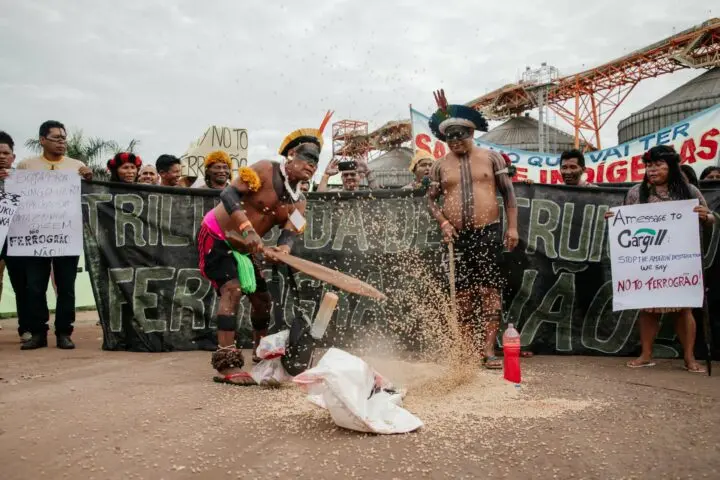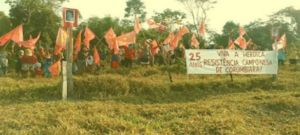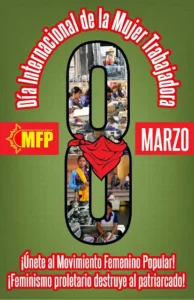
Brazil: Indigenous people, quilombolas and peasants protest against ‘Ferrogrão’
We publish an unofficial translation of an article published on AND.
Indigenous people, quilombolas and peasants have united in a protest against the pro-latifundium and pro-imperialist “Ferrogrão” project. The project was included in Lula’s PAC last year.
Indigenous people from three different ethnic groups, quilombolas and riverside peasants joined together in a protest on the 4th of February in front of the port of Cargill, a grain export monopoly, in Santarém (Pará). Indigenous people from the Munduruku, Kayapó and Panará peoples were present. The demonstrators demanded an end to the pro-latifundium and pro-imperialist enterprise and denounced the effects that the railroad will have on the peasants and indigenous people who live in the region.
Banners and signs were raised by the demonstrators during a protest. “A railroad that will have indigenous blood on it: they’re going to negotiate our lives,” said one of the banners held up. According to Edilberto Francisco, who was present at the protest and was interviewed by AND, around 60 people took part in the demonstration.
Government in, government out, Ferrogrão continues
Ferrogrão is a railway project presented ten years ago by imperialist agribusiness companies, such as ADM, Amaggi, Bunge, Dreyfus and Cargill, the target of recent protests. The idea is to cross the Brazilian territory of Mato Grosso, from the city of Sinop, to the city of Itaiuba, in Pará. There will be 933 km of tracks, along which shipments of grain planted on large estates destined for foreign markets, such as China, Europe and the Middle East, will pass.
The biggest beneficiaries will therefore be the Brazilian large estates, the backward sector of the country responsible for keeping the economy backward, stagnant and submissive to the will of the dominant imperialist powers. The railway promises to significantly reduce freight costs in Brazilian lands. Together with the exemptions given by the State that almost completely cancel out export taxes, large farmers will see a new brutal increase in profits.
Formulated in 2014, the project was initially taken over by Dilma Rousseff (PT). It was then fed by Michel Temer (MDB), Bolsonaro and, finally, returned to the hands of the PT in the third government of Luiz Inácio. In it, it was integrated into the Acceleration and Growth Project[PAC], as a way of guaranteeing the construction of the railway.
“Why is the government interested in serving the interests of agribusiness?” asks Edilberto. “Because our government is a coalition government submissive, trapped, to the interests of agribusiness henchmen and companies that export agricultural products”, he explains, before adding that: “In the National Congress, the government keeps playing the game of ‘ lose two to gain one’, ‘lose three to gain two’, and in this case the losses will all come to us”.
Ferrogrão will cross TIs and increase conflicts over land
To complete its construction, Ferrogrão will have to cross more than 40 TI’s [indigenous lands]. Six of them are in PA [State of Pará] and have a concentration of 2,600 people. Three isolated indigenous peoples also live along the route of the area, according to surveys by Infoamazônica and Joio e o Trigo. Furthermore, there are several villages of riverside peasants who live on the banks of the Tapajós River that will be affected by the construction and the developments resulting from it.
The project also promises to increase conflicts over land, as it will increase the dispute over land by big landlords in the Amazon. With cheaper shipping, more big landlords will seek to implement large estates to plant grains in the region. Furthermore, since freight from MT [Mato Grosso] to PA will also be cheaper, big landlords who were looking to migrate soybean and corn plantations from MT to the Amazon will not necessarily do so, in which case they may prioritize cattle ranching in the Amazon region.
In any case, Ferrogrão promises to increase land disputes between big landlords in the region that is already the biggest stage for land conflicts in Brazil. In 2022, four of the five states with the highest rates of land conflicts were in the Legal Amazon. There are thousands of squatter families who live in the region and face, day after day, the big landlords and their armed bands in the struggle to gain land to live and work on.
In the “Arc of Deforestation of the Amazon”, one of the routes that Ferrogrão will travel, there are at least 102 agrarian reform settlements, in addition to 16 indigenous lands. Certainly, all of them will be affected by the project, both in the most direct aspects of the project itself, and by conflicts over land resulting from the railway and its changes in the region.
Even so, the government continues with its planning. To top it off, none of the peasants or indigenous people who live there were even consulted by the government about the project.

